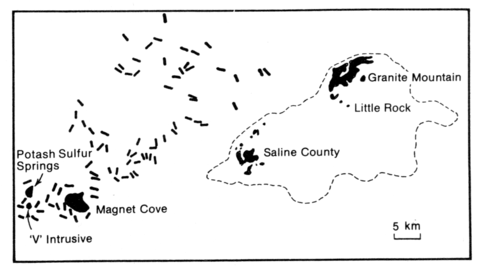stripes
Magnet Cove is an elliptically-shaped complex of some 11 km2 intruded into faulted and folded Palaeozoic shales, sandstones, cherts and minor conglomerates and limestones of the Ouachita geosyncline. The outer contacts appear to be vertical while the gross internal structure is that of a multiple ring complex. The outer ring, which together with metamorphosed sediments forms a series of arcuate ridges, consists of a range of feldspathoidal syenites, but also includes two masses of jacupirangite and one of melteigite. An intermediate ring consists of trachytic and phonolitic rocks, while the central area of the complex, defining a basin feature, is occupied by ijolite, carbonatite and lime-silicate rocks. Because of poor outcrop and deep weathering, the sequence of intrusion is not clear but Erickson and Blade (1963, p. 83) believe the order to be: (1) phonolite and trachyte, (2) jacupirangite, (3) feldspathoidal syenite, (4) ijolite, and (5) carbonatite, dykes and veins. The feldspathoidal syenites of the outer ring include sphene, sphene-garnet and sphene-cancrinite-nepheline syenites, garnet-pseudoleucite syenite and leucosyenite. Zoned aegirine-augite, some amphibole, biotite, melanite and analcime are found in most of the feldspathoidal syenites. The pseudoleucite syenite forms an almost complete ring up to about 650 m in width and occupies 21% of the complex; pseudoleucites reach 5 cm in diameter and they form 0-60% of the rock. Two masses of jacupirangite and pyroxenite occur in the northwest and northeast of the complex and comprise more than 50% pyroxene with opaques, sphene, apatite, perovskite etc. Two small areas of melteigite have also been mapped and consist of pyroxene, biotite, perovskite, nepheline, melanite and accessories. The phonolite of the intermediate ring is a trachytic textured rock in which pyroxene is altered to biotite, nepheline is also altered and there is 15-20% calcite; deuteric alteration seems to be responsible for these changes. Trachyte-phonolite occupies some 20% of the complex and forms a horseshoe-shaped ridge open to the northwest. This is a variable group of rocks of varying proportions of orthoclase, albite-andesine, nepheline, analcime, sodalite, diopside-hedenbergite, biotite, garnet, hornblende, sodic pyroxene and a wide range of accessories. Biotite-melanite ijolite grading into melanite ijolite occupies the central area of the complex and a fine grained ijolite the central northwestern part. They vary from urtites to melteigites and are dominantly composed of nepheline, much altered to thomsonite, diopsidic pyroxene, melanite and some green biotite. They are more altered in the vicinity of the carbonatites, which occupy two main areas in the central and northwestern part of the complex, together with residual phosphate deposits which drilling has indicated are underlain by carbonatite. The carbonatites are coarse sovites with areas enriched in apatite, monticellite, magnetite, perovskite, kimzeyite, biotite and pyrite. Inclusions of ijolite with reaction rims occur, and carbonatite veins the surrounding ijolites. A small area of lime-silicate rock lies in the central ijolite and has some affinities with uncompahgrite because of large (greater than 45 cm) partly altered melilite crystals, together with idocrase, diopside, apatite and miarolitic cavities lined with aegirine, apatite, andradite etc. Dykes and plugs are particularly abundant within the complex and include tinguaite, including pseudoleucite-bearing types, analcime-olivine melagabbro, nepheline syenite pegmatite, trachytes, garnet fourchite and syenitic and nepheline syenitic aplites. Outside the complex dykes are also very numerous (Erickson and Blade, 1963, Fig. 4), usually radial or concentric and up to 8 m in width and nearly 1.5 km in length. They include pegmatites, aplites, syenites and trachytes, tinguaites and lamprophyres (see Erickson and Blade, 1963, Table 37 for petrographic details). Many types of veins can be distinguished within the complex and contact zone, a number of which contain significant mineral deposits. A metamorphic aureole extends for 330-800 m from the contact and is essentially of hornfelses; only within the innermost few metres is there any alteration akin to fenitization. Modal and chemical data for rocks and minerals will be found in Erickson and Blade (1963), and data on the following are available: oxygen and carbon isotopes for calcite and magnetite (Conway and Taylor, 1969); Nd isotopes in carbonatite (Basu and Tatsumoto, 1980); sulphur isotopes in pyrite from carbonatite (Mitchell and Krouse, 1975); REE in eudialyte and feldspar from eudialyte-nepheline pegmatite (Fryer and Edgar, 1977); palaeomagnetics (Scharon and Hsu, 1969); and magmatic and hydrothermal inclusions in carbonatite minerals (Nesbitt and Kelly, 1977). Innumerable papers on individual minerals have been published and are listed by Erickson and Blade (1963, p. 2)
BASU, A.R. and TATSUMOTO, M. 1980. Nd-isotopes in selected mantle-derived rocks and minerals and their implications for mantle evolution. Contributions to MIneralogy and Petrology, 75: 43-54.
CONWAY, C.M. and TAYLOR, H.P. 1969. O18/O16 and C13/C12 ratios of coexisting minerals in the Oka and Magnet Cove carbonatite bodies. Journal of Geology, 77: 618-26.
ERICKSON, R.L. and BLADE, L.V. 1963. Geochemistry and petrology of the alkalic igneous complex at Magnet Cove, Arkansas. Professional Paper, United States Geological Survey, 425: 1-95.
FRYER, B.J. and EDGAR, A.D. 1977. Significance of rare earth distribution in coexisting minerals of peralkaline undersaturated rocks. Contributions to MIneralogy and Petrology, 61: 35-48.
FRYKLUND, V.C., HARNER, R.S. and KAISER, E.P. 1954. Niobium (columbium) and titanium at Magnet Cove and Potash Sulphur Springs, Arkansas. Bulletin, United States Geological Survey, 1015-B: 23-57.
MITCHELL, R.H. and KROUSE, H.R. 1975. Sulphur isotope geochemistry of carbonatites. Geochimica et Cosmochimica Acta, 39: 1505-15.
NESBITT, B.E. and KELLY, W.C. 1977. Magmatic and hydrothermal inclusions in carbonatite of the Magnet Cove complex, Arkansas. Contributions to MIneralogy and Petrology, 63: 271-94.
SCHARON, L. and HSU, I-C. 1969. Paleomagnetic investigation of some Arkansas alkalic igneous rocks. Journal of Geophysical Research, 74: 2774-9.
ZARTMAN, R.E., BROCK, M.R., HEYL, A.V. and THOMAS, H.H. 1967. K-Ar and Rb-Sr ages of some alkalic intrusive rocks from central and eastern United States. American Journal of Science, 265: 848-70

